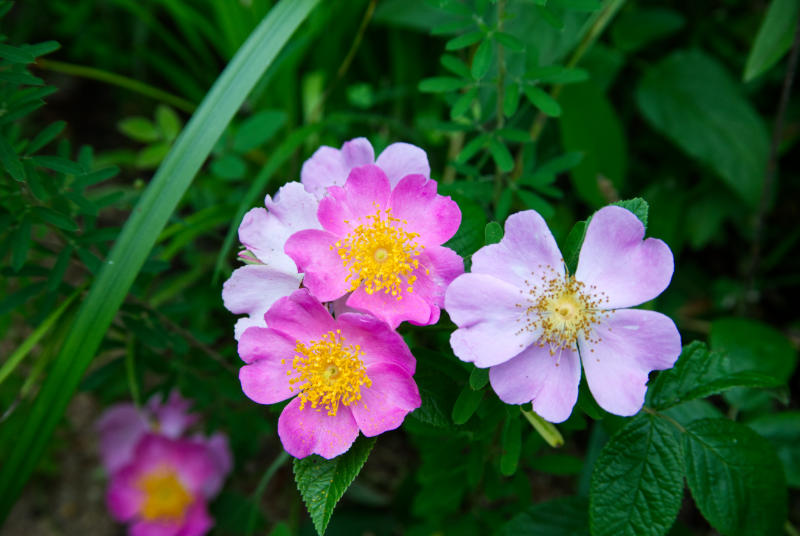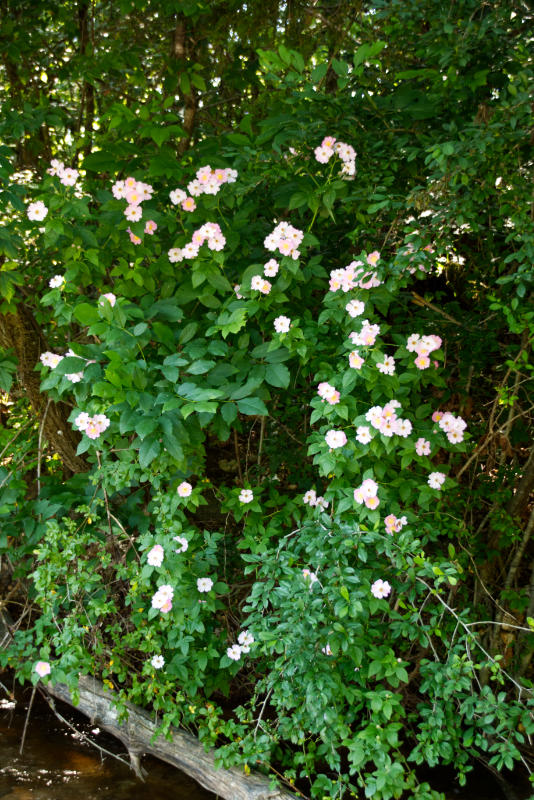
The wild rose is a delicate and beautiful flower that often gets overlooked. But don’t let its dainty appearance fool you, this little blossom packs a punch in both beauty and benefits. From its sweet scent to its therapeutic properties, the wild rose is a true gem of the natural world. But what makes this flower truly special? In this article, we’ll delve into the fascinating world of wild roses and explore their history, uses, and how to incorporate them into your daily life. So, whether you’re a green thumb or simply enjoy the finer things in life, keep reading to discover the enchanting world of wild roses.
Wild rose species are all related to the roses you might plant in your garden. In fact, domesticated roses are descended from wild varieties. There are a number of wild rose species in the Ozarks. Two that we find often are the Carolina Rose and the Japanese Rose (also called Multiflora Rose).
Wild Rose Habitat
Wild roses are found across North America in a variety of habitats, ranging from high-altitude mountains to lowland forests. They are hardy and adaptable plants that can grow in both dry and moist soils and are often found on the edges of forests, along streams, and in open meadows.
These plants prefer sunny locations with well-drained soil and can tolerate both alkaline and acidic soils. They are also able to withstand periods of drought, making them a resilient addition to any garden.
Wild roses are thorny bushes that can grow up to 10 feet tall, with multiple stems branching out from the base. Their leaves are typically serrated and have a glossy texture, and they produce stunning pink or white flowers that bloom in late spring or early summer.
It’s important to note that while wild roses are beautiful and beneficial plants, they can also become invasive in certain areas. If you are planning to plant wild roses, make sure to choose a suitable location where they will not crowd out other native plants.
Whether you’re looking to add a splash of color to your garden or harvest the nutritious rose hips, these plants are a valuable addition to any landscape.

Wild Rose Uses
You can use wild roses in the same way cultivated roses are used. Many commercial skincare preparations contain the essential oil or rose water obtained from commercial operations. You can create your own skincare preparations at home for a fraction of the cost. You’ll just have to get out and smell the roses!
The flowers and leaves have anti-inflammatory, anti-spasmodic, astringent, antiseptic, and aphrodisiac properties. This makes an extract from them great for your skin. You could create a skin-loving oil by placing the leaves and flowers into a jar and covering them with a light oil like grapeseed oil. The infused oil can be used like it is, or you could make a skin balm by adding beeswax.
It is useful for minor scrapes and skin irritations, moisturizing, cooling a sunburn, and many other uses. It may even help to reduce fine lines and wrinkles by helping to moisturize the skin, while the astringent properties help tighten the skin.
You can also do a glycerin extraction using plant glycerin. Replace the carrier oil from the oil extraction method with glycerin. Place the flowers and leaves in a jar and pour glycerin over them to completely cover them. Place it in a dark cupboard for 30-60 days. The longer you let it steep the more plant constituents you will be able to extract. This is the process for making what is known as a glycerite.
Edible Uses
One of the most well-known edible uses of the wild rose is the harvesting of the nutrient-rich rose hips.
Rose hips are the small, red fruit that develop on the plant after the flowers have bloomed. They are packed with vitamin C and other antioxidants, making them a valuable addition to any diet. To harvest rose hips, wait until they are fully ripened, usually in late summer or early fall. They can be eaten fresh or dried and used in a variety of recipes, from jams and jellies to teas and syrups.
The petals of the wild rose are also edible and can be used to make a fragrant and delicious tea. Simply steep the petals in hot water for several minutes, then strain and enjoy. The petals can also be used to make rose water, a popular ingredient in Middle Eastern and Indian cuisine.
Recipes
Wild Rose Jelly
Wild rose jelly is a delicious way to enjoy the sweet and fragrant flavor of this beautiful flower. Here’s a simple recipe to make your own:
Ingredients:
- 4 cups of wild rose petals
- 4 cups of water
- 1 package of powdered pectin
- 4 cups of sugar
- Juice of 1 lemon
Instructions:
- Rinse the rose petals in cold water and remove any debris or insects.
- In a large pot, combine the rose petals and water. Bring to a boil, then reduce heat and simmer for 30 minutes.
- Strain the rose petals and reserve the liquid. You should have about 3 cups of liquid.
- In a separate pot, mix the powdered pectin and 1 cup of sugar. Add the rose petal liquid and lemon juice and stir well.
- Bring the mixture to a rolling boil, stirring constantly. Add the remaining sugar and continue to stir until the sugar has dissolved.
- Allow the mixture to boil for 1-2 minutes, then remove from heat.
- Skim off any foam that has formed on the surface of the jelly.
- Ladle the jelly into sterilized jars, leaving about 1/4 inch of space at the top. Wipe the rims of the jars with a clean, damp cloth.
- Process the jars in a hot water bath for 10 minutes.
- Remove the jars from the water bath and allow them to cool completely. Check the seals on the jars to ensure that they are properly sealed.
Your homemade wild rose jelly is now ready to enjoy! Spread it on toast or biscuits, or use it as a glaze for meat or poultry. Store any unopened jars in a cool, dark place for up to 1 year. Once opened, refrigerate the jelly and use it within a few weeks.
Wild Rose Syrup
Wild rose syrup is a sweet and tangy treat that is easy to make and can be used in a variety of ways, from flavoring cocktails to drizzling over pancakes or ice cream. Here’s a simple recipe to make your own:
Ingredients:
- 4 cups of wild rose petals
- 4 cups of water
- 4 cups of sugar
- Juice of 1 lemon
Instructions:
- Rinse the rose petals in cold water and remove any debris or insects.
- In a large pot, combine the rose petals and water. Bring to a boil, then reduce heat and simmer for 30 minutes.
- Strain the rose petals and reserve the liquid. You should have about 3 cups of liquid.
- Return the liquid to the pot and add the sugar and lemon juice. Stir well.
- Bring the mixture to a boil, stirring constantly to dissolve the sugar.
- Reduce heat and simmer for 10-15 minutes, or until the syrup has thickened slightly.
- Remove the pot from heat and allow the syrup to cool for a few minutes.
- Pour the syrup through a fine-mesh strainer to remove any solids.
- Transfer the syrup to sterilized jars or bottles.
- Store in the refrigerator for up to 1 month.
Your homemade wild rose syrup is now ready to use! Drizzle it over pancakes, ice cream, or yogurt, or use it to flavor cocktails and other drinks. The syrup can also be used as a sweetener in baking or added to sauces for a sweet and tangy flavor. Experiment with different ways to use the syrup and enjoy the sweet taste of the wild rose.
Conclusion
Wild rose is prolific in many areas of the Ozarks. They can be used medicinally, especially for the skin, and are also edible raw or cooked. If you decide to harvest wild roses to use please be sure and harvest sustainably from areas away from roads or areas treated with chemicals. Always be sure you are 100% confident of your identification before attempting to consume any wild plant. If you aren’t sure, get a good field guide or an experienced forager to help you. When in doubt, spit it out!
FAQs:
Q: What is a wild rose called?
A: A wild rose is also known as a species rose or a native rose.
Q: What is the difference between a wild rose and a rose?
A: The main difference between wild roses and cultivated roses is that wild roses are native to a particular region and grow naturally, while cultivated roses are bred and grown for specific characteristics, such as color or fragrance.
Q: Where does the wild rose grow the best?
A: Wild roses are adapted to a variety of environments and can grow in many different types of soil and climates. However, they typically prefer well-drained soil and full sun.
Q: Should I get rid of a wild rose?
A: It depends on the situation. Wild roses can be invasive and may need to be removed if they are taking over an area or competing with other plants. However, they can also provide habitat for wildlife and have medicinal and culinary uses.
Q: Where do wild roses grow in the US?
A: Wild roses are found throughout the United States, but they are most common in the western states and the Midwest.
Q: Where do wild roses grow best?
A: Wild roses grow best in areas with well-drained soil and full sun. They can tolerate a range of temperatures and climates, but they do not do well in extremely wet or dry conditions.
Q: What state has the wild rose?
A: Wild roses are found in many states throughout the US, but some states with particularly abundant populations include California, Oregon, and Montana.
Q: How do I identify a wild rose?
A: Wild roses typically have five petals and come in shades of pink, white, or red. They have serrated leaves and thorny stems. The hips (fruit) are round and usually red or orange.
Q: What are the characteristics of the wild rose plant?
A: Wild roses are typically shrubs that range in height from 2 to 10 feet. They have thorny stems, serrated leaves, and fragrant flowers. The hips (fruit) are edible and rich in vitamin C.
Q: What is a wild rose-like shrub?
A: A wild rose shrub typically has multiple stems and a rounded shape. The leaves are green and serrated, and the flowers are typically pink or white with five petals.
Q: What does a wild rose flower look like?
A: Wild rose flowers typically have five petals and come in shades of pink, white, or red. They are fragrant and have a distinctive, sweet smell.